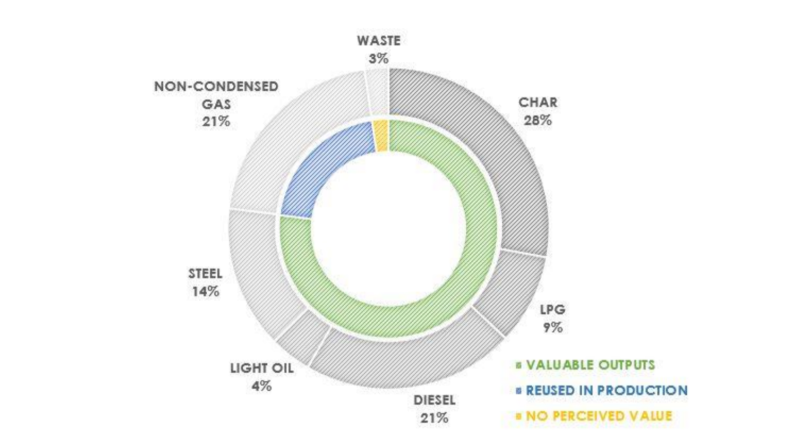# Pyrolysis
Disclosure/Foreword: My family recently started a company called Eneform to find a commercially viable solution to waste tires. I use some of their data in this article.
Although it's not a well-known problem, tire waste is a big one. Globally, there are about 1 billion tires that go to waste every year. There aren't many ways to responsibly dispose of tires but the most promising solution seems to be pyrolysis.
# What is pyrolysis
To quickly summarise pyrolysis - you put the tires in a vacuumed chamber and heat them to around 500 degrees celsius. The heat causes the tires to break down into 4 useable products: diesel, LPG, steel, and carbon. All of these products can have commercial value; the carbon can actually be used to make new tires. Even the heat required within the process is generated from the waste tires, so once you start the process it can be self-sustaining. You can sell the outputs directly or you can use them to generate power which can be sold back to the grid.
Pyrolysis has been used successfully in several industries, and can be either done in batches or through a continuous cycle (like a factory line). In a continuous process the tyre stock feeds through a pyrolysis tube at a constant speed. In a batch process the tyre stock is loaded into the tube, then the system is heated.
The outputs are cleaner and more consistent using a continuous process as the heat is maintained at a constant temperature.
The Eneform system also combines many smaller pyrolysis tubes together (rather than using one large one). This means that the cost to start a site is low and then sites can scale up once they become commercially sustainable.
# No good solutions
So why is this important? There are currently only a small number of ways to deal with end-of-life tires. Most of the tires are either stockpiled or sent to landfill. Tires in landfills can tear the liners which causes contaminants to leach into surface and ground water. Stockpiles harvest pests and are a huge fire risk. Surprisingly the most common cause of the fires are humans that want to retrieve the relatively valuable steel cable that is in the tires.
Other alternatives include:
# Recycled Uses
This is a broad category and covers a number of different ways that waste tires can be used. These include: reuse as a base for new tires; asphalt and concrete aggregate; and construction of walls, roadways, houses, and artificial reefs. These options are seen as inefficient and are ultimately unsustainable with the increasing supply of waste tires. Also, due to their heavy metal and other pollutant content, tires pose a risk for the leaching of toxins into the groundwater when placed in wet soils.
# Fuel
Tire derived fuel (TDF) is composed of shredded tires, commonly mixed with coal or other fuels such as wood to be burned in concrete kilns, power plants, or paper mills. Tires produce the same energy as petroleum and approximately 25% more energy than coal. Historically, there has not been any volume use for waste tires other than burning that has been able to keep up with the volume of waste generated yearly. However, the use of TDF for heat production is controversial due to the possibility of toxin production.
# Devulcanization
This is the process of "recycling" rubber. Vulcanization is a chemical process for making rubber/polymers more durable (via the addition of sulfur, curatives, or accelerators). Devulcanization is the reversal of this process. Unfortunately this technology has not produced material that can supplant fresh, unvulcanized materials. The main problem is that the carbon-sulfur linkages require costly reagents and heat to be "broken" before the material can be reused.
# The value in a tire
There is a surprising amount of value left in a tire. The trouble is extracting that value economically and environmentally. While tire derived fuel goes a long way to accessing this potential, pyrolysis offers a much cleaner and efficient solution.
 Analysis of the Eneform process
Analysis of the Eneform process
You can see there is a small quantity of pyrolysate is considered “waste”. While this waste could be used in heavy fuel burners, for financial purposes Eneform consider it a disposal cost. It is expected that this quantity will decrease in production when using a more efficient distillation column, but even so, the total waster for an average car tire has been reduced from 14kg to 420g. All other outputs are valuable.
The waste industry isn't necessarily the sexiest, but there is more than enough room for innovation and entrepreneurship.